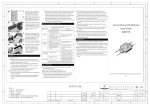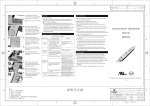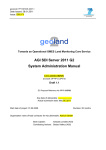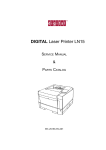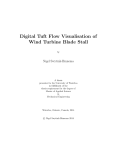Download 123-128_jo_kones_201..
Transcript
Journal of KONES Powertrain and Transport, Vol. 20, No. 4 2013 ISSN: 1231-4005 e-ISSN: 2354-0133 DOI: 10.5604/12314005.1137400 PRELIMINARY TESTS ON A COMBINED HEAT AND POWER UNIT FED WITH GAS FUELS Maciej Imioáek, Grzegorz Boruta, Andrzej PiĊtak University of Warmia and Mazury, Faculty of Technical Sciences Department of Mechatronics and Technical and Information Technology Education Oczapowskiego Street 2, 10-719 Olsztyn, Poland tel.: +48 89 5245101, fax: +48 89 5245150 e-mail: [email protected], [email protected], [email protected] Jonas Matijošius Vilnius Gediminas Technical University Faculty of Transport Engineering J. Basanaviþius Street 28, Vilnius, Lithuania e-mail: [email protected] Abstract This paper presents a model unit demonstrating the possibility of using a PBCHP10VB CHP unit driven by a piston combustion engine fed with gas fuels for heat and power cogeneration. A mobile unit available in the Department enables heat and power cogeneration at any place with available gas fuel, e.g. compressed in a pressure tank or from a production and transmission system. A radiator is connected to the unit’s heat connection for demonstrative purposes – this is the simplest model of a network using the heat generated by the unit, with the possibility of easy connection to another network for heating rooms and/or tap water instead of this radiator. Any three-phase load (e.g. a single phase converter) can be connected to the unit’s power connection. A constructed mobile power generator fed with alternative gas fuels (e.g. biogas) is described which can be used in the field in a biogas system for power generation with simultaneous heat recovery. The results of the first preliminary tests on the effect of the type of gas fuel used on the obtained electrical and thermal power and on the composition of exhaust gas from the driving combustion engine are presented. A plan for further tests is also outlined. Keywords: heat and power cogeneration, piston combustion engine, gas fuel 1. Introduction The demand for electrical energy (and in some areas of the world also for heat) is universal today. This concerns not only urban and industrial centres but (in this era of widespread interest in the possibility of using diverse power-fed devices) also in raising the quality of life in areas for which the construction of power and heat transmission lines is unprofitable. For such areas, the only universal solution is the use of local power plants with current generators driven by engines fed by locally available solid, liquid, or gas fuels. These power plants can supply power to local isolated power networks and diverse load points connected with the network. If there is a demand for heat (for heating rooms or tap water) and an appropriate local network for its transmission exists, combined power and heat generation (or their cogeneration) is more economically justified than power generation alone using electric water heaters. It is desirable that the device for heat and power cogeneration (combined heat and power unit) working for local isolated consumers be fed with a fuel, which is available nearby, in the immediate environment of this device’s place of operation. In general, these fuels do not have to be conventional fuels, widely offered by oil corporations and fuel distributors, i.e. petrol, diesel oils, fuel oils, natural gas or petroleum gas. M. Imioáek, G. Boruta, A. PiĊtak, J. Matijošius Work on the possibility of using CHP units fed with unconventional fuels to meet the needs of small local consumers isolated from worldwide power and fuel distribution networks is being conducted at many research centres as well as at our Department. A mobile unit available in the Department enables heat and power cogeneration at any place with available gas fuel, e.g. compressed in a pressure tank or from a production and transmission system (Fig. 1). This unit includes a PBCHP10VB CHP unit placed on a trailer. A radiator is connected to the unit’s heat connection for demonstrative purposes – this is the simplest model of a network using the heat generated by the unit, with the possibility of easy connection to another network for heating rooms and/or tap water instead of this radiator. Any three-phase load (e.g. a single-phase converter) can be connected to the unit’s power connection. A specially constructed device with a heater for heating up water in the tank with electric power steplessly adjusted up to 10 kW was used as the load during the tests presented below (Fig. 2). Fig. 1. Mobile unit for heat and power cogeneration on the left – fully enclosed for transport; on the right – with uncovered access to the control panel and to the gas (feed), power and heat (outlet) connections Fig. 2. Load The used CHP unit is fed by a spark-ignition combustion engine factory adapted for feeding with gas fuels: natural gas (NG), i.e. methane, and liquefied petroleum gas (LPG), i.e. a mixture of propane and butanes. This paper presents the results of preliminary tests on this unit when it was fed exactly with these two gas fuels. Of course, in accordance with the assumptions presented above, it is planned to perform similar tests for unconventional gas fuels, especially for biogas because of the agricultural/forest character of Warmia and Mazury, the region of our University. 124 Preliminary Tests on a Combined Heat and Power Unit Fed with Gas Fuels 2. Measuring apparatus configuration Selected operating parameters of the engine driving the tested unit, i.e. the percentage oxygen (O2) and carbon dioxide (CO2) content values in exhaust gas, the number of carbon monoxide (CO) molecules per one million exhaust gas molecules and the value of the air excess factor (O) for the defined gas fuels (NG or LGP), were recorded during the preliminary tests. These values were recorded for different electrical power values of the connected load. The temperature of liquid flowing into the heat exchanger from the unit (the working heating medium) as the parameter determining its capacity for heating water in an external system was recorded simultaneously with the values of the selected operating parameters of the unit’s engine and the load power value. The values of the selected operating parameters of the unit’s engine were measured and determined with a Bacharach ECA 450 combustion efficiency analyser. The determination error for the measured O2 contents is 0.3% and the determination error for the measured CO contents is 5% of the indicated values. The CO2 content and O factor values are determined by the analyser and its manufacturer does not provide the accuracy of their determination. The electrical power of the load, or actually the electrical load of the CHP unit’s current generator, was read from the display on its control panel. The temperature of the working heating medium feeding heat to the heat exchanger – a water heater in the external system – was measured with the thermocouple which is a component of the UNI-T UT53 millimetre. The temperature determination error was assumed at 1 °C. Testing the composition of this biogas will also be required during future research on the possibility of using biogas for feeding the engine of the tested CHP unit. It is planned to use a Gas Data GFM410 biogas analyser for this purpose. The tests described here did not require the use of this analyser because, as already mentioned, the unit was fed with natural gas from the municipal system in Olsztyn and liquefied petroleum gas from a cylinder from a gas station, i.e. gas fuels with a standardized composition. 3. Test results Selected operating parameters of the CHP unit after warming up the driving engine to operating temperatures were recorded during the presented tests. The results were recorded directly after the activation of the unit’s engine radiator fans, before the exhaust gas composition changed as a result of an automatic increase in the consumption of gas fuel needed to generate higher electrical power in the unit’s generator as well as feeding the external load for the fans. The tests were performed for no external electrical load and for small loads not exceeding half their nominal range (i.e. to ca. 5 kW). The heat load of the unit during the tests was invariable. Three measurements were performed for each of the test points (set external electrical load values) and the mean values of these measurements were recorded. Figure 3 shows the temperature values of the unit’s working heating medium flowing into the heat exchanger with water in the external system for different external electrical load values and both used gas fuels. It can be seen that with an increasing external electrical load this temperature rises to a small degree (by ca. 3 °C) from ca. 71 to ca. 74°C when the unit is fed with natural gas. Similar temperature values, though lower by a fraction of a degree, were observed when the unit was fed with petroleum gas. The temperature of the heated water in the external system will, of course, be lower, depending on the intensity of its flow through the exchanger and on the rate of its giving up heat to the environment (on the temperature of heated water flowing into the exchanger). Figures 4-7 show the values of the selected recorded operating parameters of the engine driving the tested CHP unit for different set external electrical load values and both used gas fuels. It can be seen that with an increasing external electrical load and increasing consumption of gas fuel automatically adjusted by the system maintaining the rotational speed of the crankshaft of the engine driving the unit independent of its external loading by the current generator, air 125 M. Imioáek, G. Boruta, A. PiĊtak, J. Matijošius 75 LPG Trcg [oC] 74 NG 73 72 71 70 0 1 2 3 4 oe [kW] 5 6 7 Fig. 3. Temperature of the CHP unit’s working heating medium Trcg flowing into the heat exchanger with water in the external system for different external electrical load oe values and both gas fuels used (Trcg = working heating medium temperature, oe = electrical load) consumption increases relatively slowly or not at all. As a consequence, the fuel-air mixture burnt in the engine becomes increasingly rich (the value of the air excess factor Odecreases – Fig. 6) and the value of unused oxygen in exhaust gas also decreases correspondingly – Fig. 4. These changes are more intense when the unit is fed with natural gas, while it can be seen that feeding the unit with petroleum gas entails the use of a fuel-air mixture with an almost stoichiometric composition, with only a small air excess and a small oxygen residue in the exhaust gas – not exceeding 1% of the exhaust gas volume. 2000 LPG 3 CO[ppm] O2 [%] 3.5 NG 2.5 2 1800 1200 1 1000 0.5 800 0 600 1 2 3 4 oe [kW] 5 6 NG 1400 1.5 0 LPG 1600 0 7 1 2 3 4 oe [kW] 5 6 7 O2 content (%) oe = electrical load CO content (ppm) oe = electrical load Fig. 4. O2 content in exhaust gas from the CHP unit’s engine for different external electrical load oe values and both gas fuels used Fig. 5. CO content in exhaust gas from the CHP unit’s engine for different external electrical load oe values and both gas fuels used As for the CO content in exhaust gas from the unit’s engine (Fig. 5), feeding the unit with natural gas, i.e. methane combustion, gives clearly better effects – the used external electrical loads CO emission did not exceed 1400 ppm, reaching the observed minimum for the load of ca. 3 kW. When the unit was fed with petroleum gas, i.e. when a mixture of propane and butanes was burnt, a gradual rapid rise in the indicated CO content value was observed after insertion of the exhaust gas analyser probe into the exhaust pipe from 0 ppm (for pure air) to a value exceeding the analyser’s upper measuring range limit, i.e. 2000 ppm – exactly this value indicated by the instrument is marked in Fig. 5, but awareness is needed that the actual value of the CO content in the exhaust gas is higher. Likewise, natural gas seems to be the better gas fuel with respect to the CO2 content in exhaust gas, which is around twice lower for this fuel than when the unit is fed with petroleum gas (Fig. 7). The CO2 emission level rises with increasing external electrical load to such a small degree that it can be assumed to be constant. 126 Preliminary Tests on a Combined Heat and Power Unit Fed with Gas Fuels 1.2 25 O LPG CO2 [%] LPG NG 1.15 20 NG 15 1.1 10 1.05 5 1 0 0 1 2 3 4 oe [kW] 5 6 7 0 1 2 3 4 oe [kW] 5 6 7 oe = electrical load CO2 content (%) oe = electrical load Fig. 6. Air excess factor O value for the CHP unit’s engine for different external electrical load oe values and both gas fuels used Fig. 7. CO2 content in exhaust gas from the CHP unit’s engine for different external electrical load oe values and both gas fuels used 4. Conclusions The conducted experiment shows that for environmental reasons (CO and CO2 emission levels) it is better to feed the tested CHP unit with natural gas (methane) than with petroleum gas (a mixture of propane and butanes). This is of great importance when the unit is fed with biogas, whose main hydrocarbon component is methane. Testing a biogas-fed CHP unit is the planned main part of research into the possibility of using alternative, unconventional gas fuels with varied, but closely-controlled hydrocarbon contents for feeding low-capacity CHP units. It also seems necessary to carry out tests during which the tested unit will operate continuously and in a long-term manner for several hours when loaded with variable external electrical and heat loads (as in its normal use) to determine the ideal times for selected operating parameters. References [1] CHP Combined Heating & Power Unit, User Manual, Power Blessed Co., Ltd, Shanghai, P. R. China. [2] Single and three phase gas CHP units with 10 kW/25 kVA power. [3] User manual, Gas Data GFM410 portable biogas analyzer, OMC ENVAG Sp. z o.o. (LLC), v12.00e, Warsaw. [4] ECA 450 combustion efficiency analyzer. Operating manual 0024-9400. Bacharach/InterTechnology, Rev. 5, Wrocáaw 2010.










